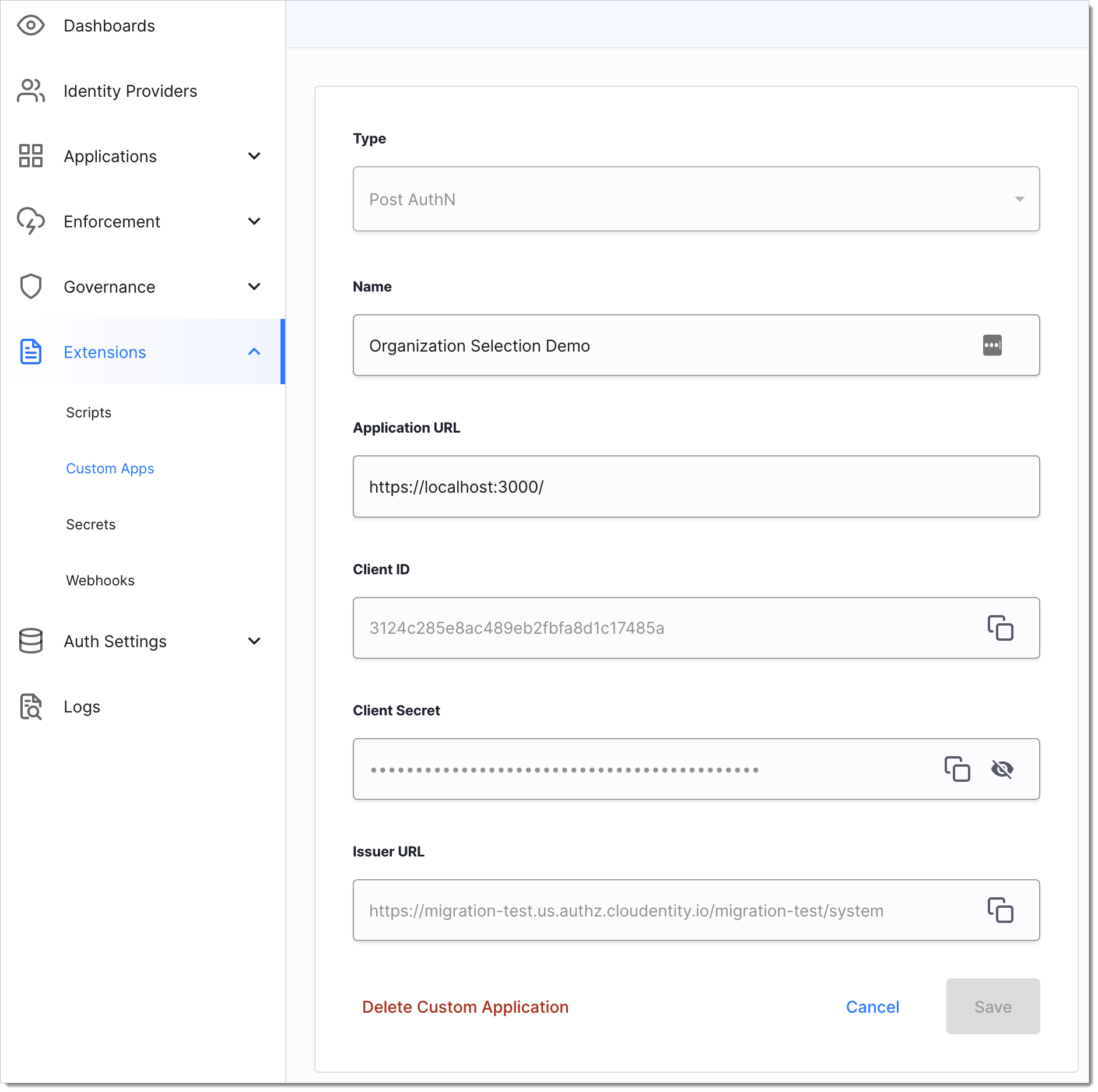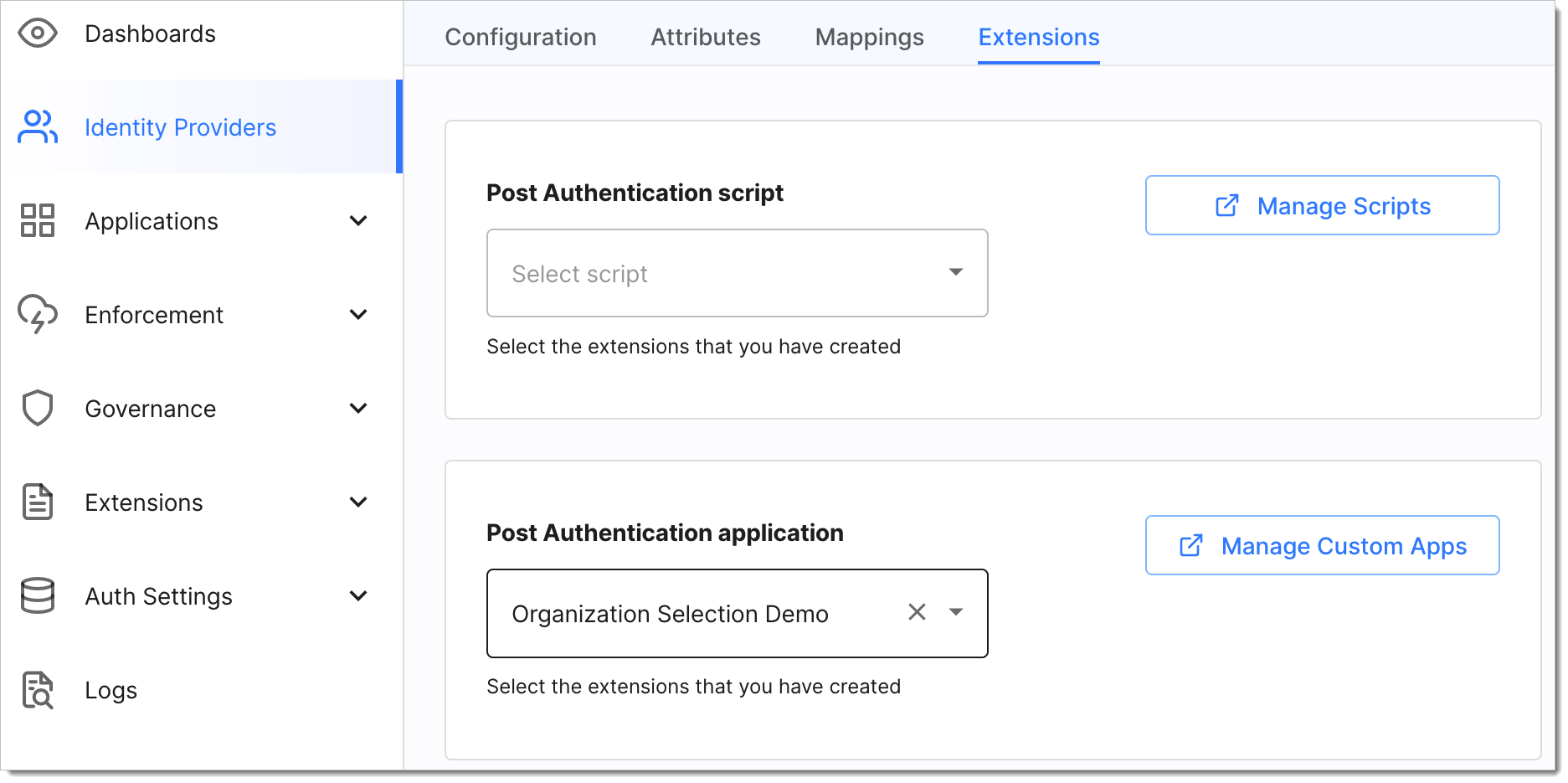Integrating Third-party Applications for User Authentication
Connect third-party applications to ensure the correct and comprehensive authentication context resulting from user's authentication.
Feature flag
Post Authentication applications must be explicitly enabled in your tenant using the custom_apps feature flag. To enable the feature, contact SecureAuth Sales Team.
Register Application in SecureAuth
Go to Extensions > Custom Apps.
Click + Custom Application.
Fill in the application data.
Field
Description
Type
Application type
Name
Name to identify this application
Application URL
Your third-party application URL that SecureAuth will redirect the user to during the
authentication process
Click Create.
Your application is now added to SecureAuth as a client in the system workspace. It generates a Client ID and Client Secret so that your application can authenticate with SecureAuth to perform various operations.
Example Third-party Application registration

Associate Application to IDP
Go to Authentication > Providers > IDP of your choice > Extensions.
In the Post Authentication application field, select your application. Once selected, users will be redirected to the application after login.
Example Third-party Application association

Post-Authn Success Flow
Use case: After authentication, the Post-Authn Third-party Application prompts the user for additional information and that information is added to the user's authentication context.
Abstract Flow
Add Post-AuthN Success Flow
SecureAuth Authenticates the user
SecureAuth redirects to the
Application URLspecified in your Custom App configuration and adds a query string with login_id and login_state.https://myapplication.com?login_id=REDACTED&login_state=REDACTEDThe Third-party Application receives the redirect with the query string.
Authenticate to SecureAuth using
client_secret_basicmethod with the generated credentials from registering the Third-party Application (Client ID, Client Secret) POST Authn-client-secret-basic.Retrieve the user's current session GET post-authn-session.
Retrieve additional information from Third-Party datastore.
Display options to user.
User selects an option and clicks Submit.
Construct the Authn Complete JSON and put the user selected values into the authentication_context
{ "authentication_context":{ # User's authentication context "organizationId":"6502", # Additional attributes "organizationName":"Acme Inc.", "permissions":[ "acme:ViewDashboard", "acme:CreateOrder", "acme:ViewOrder" ] }, "id":"REDACTED", # Required login_id "login_state":"REDACTED" # Required login_state }Send post-auth Complete with the authentication_context POST post-authn-complete.
Receive SecureAuth response containing redirect.
{ "redirect_to":"https://my-tenant.us.authz.cloudentity.io/my-tenant/my-workspace/oauth2/authorize?..." }Execute the
redirect_tocontained in the SecureAuth response.
SecureAuth proceeds to the next step in the Authentication process.
Post-Authn Abort Flow
Use case: After authentication, the Post-Authn Third-party Application process failed.
SecureAuth authenticates the user.
SecureAuth redirects to the
Application URLspecified in your Custom App configuration and adds a query string withlogin_idandlogin_state:https://myapplication.com?login_id=qwerty&login_state=asdfgThe Third-party Application receives the redirect with the query string.
Authenticate to SecureAuth using
client_secret_basicmethod with the generated credentials from registering the Third-party Application (Client ID, Client Secret) POST Authn-client-secret-basic.Retrieve the user's current session via GET post-authn-session.
Retrieve additional information from Third-Party datastore.
An error occurs or the user lacks permission, organization, etc.
Construct the abort JSON.
{ "status":403, "error":"AccessDenied", "error_description":"User denied access", "id":"REDACTED", "login_state":"REDACTED" }Send post-auth Abort with the abort JSON via POST post-authn-abort.
Receive SecureAuth response containing redirect
{ "redirect_to":"https://my-tenant.us.authz.cloudentity.io/my-tenant/my-workspace/oauth2/authorize?..." }If the SecureAuth error page is desired, execute the
redirect_tocontained in the SecureAuth response.Else, display third-party error page. The Third-party Application does not return to SecureAuth in this case.
If redirected back to SecureAuth, SecureAuth displays a generic authentication failure message.